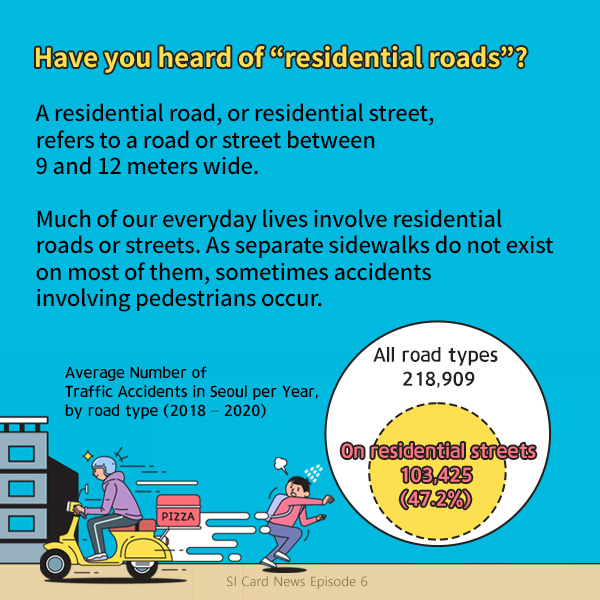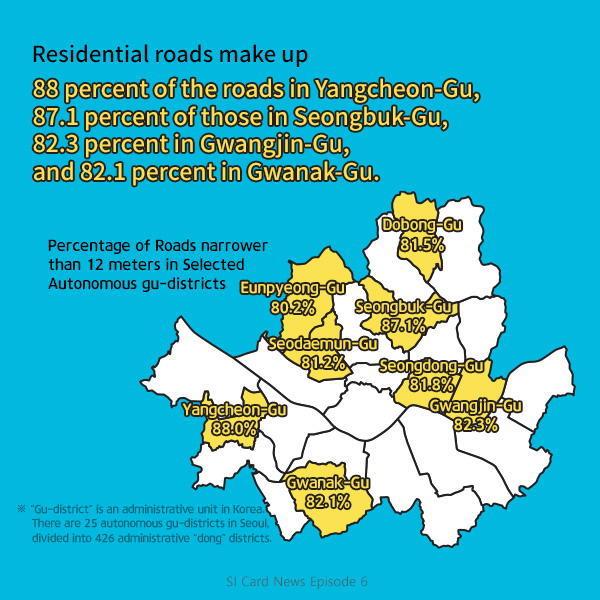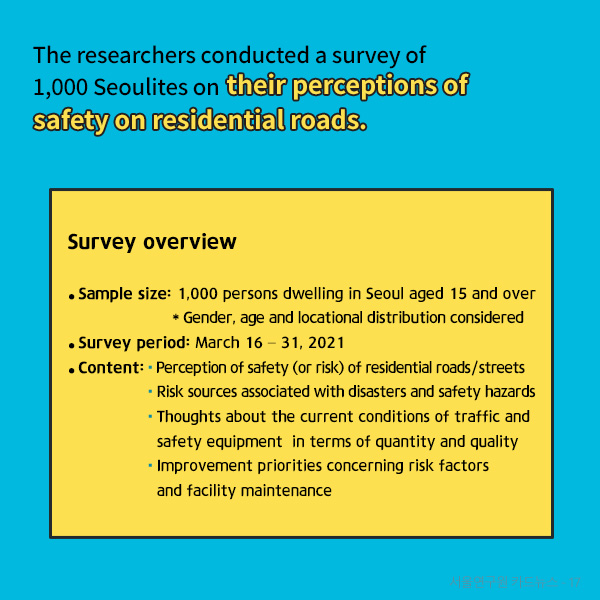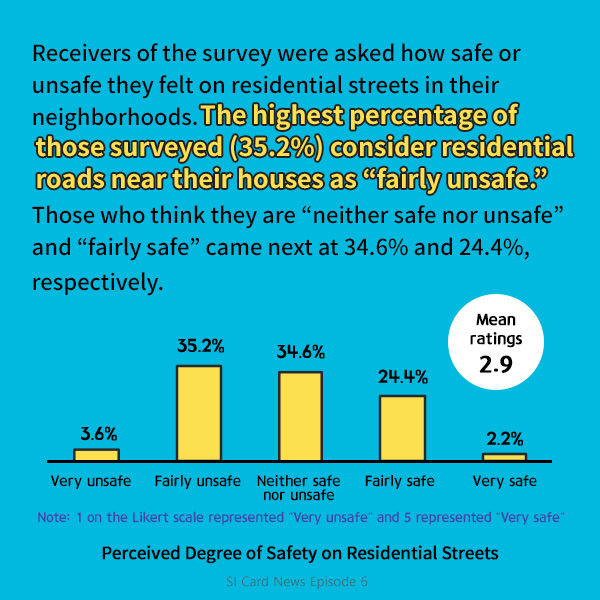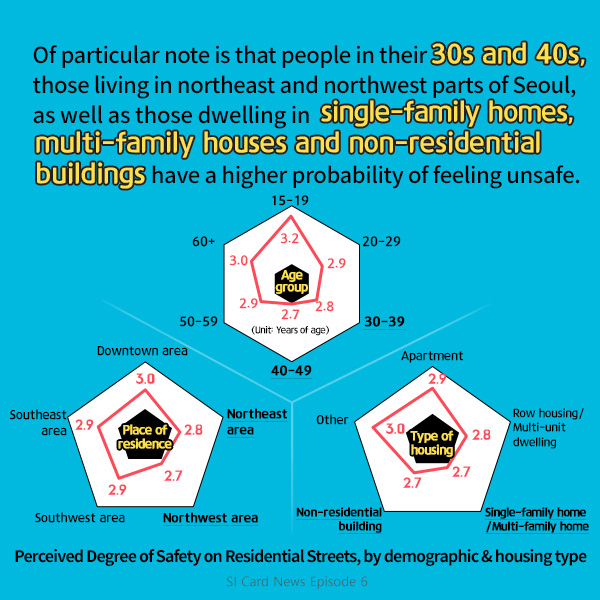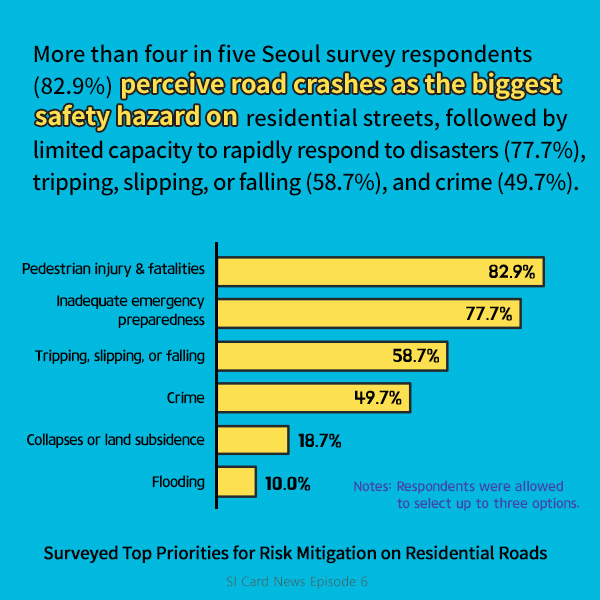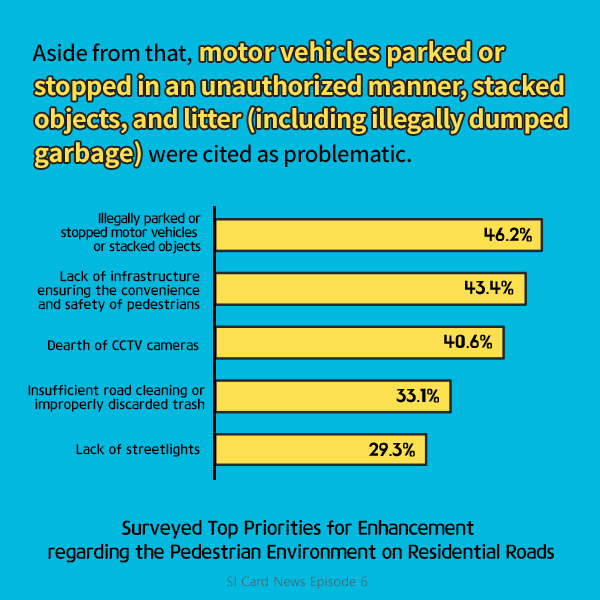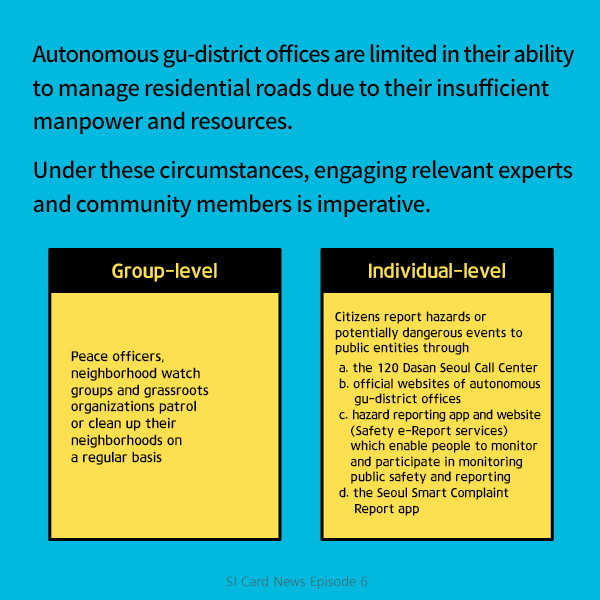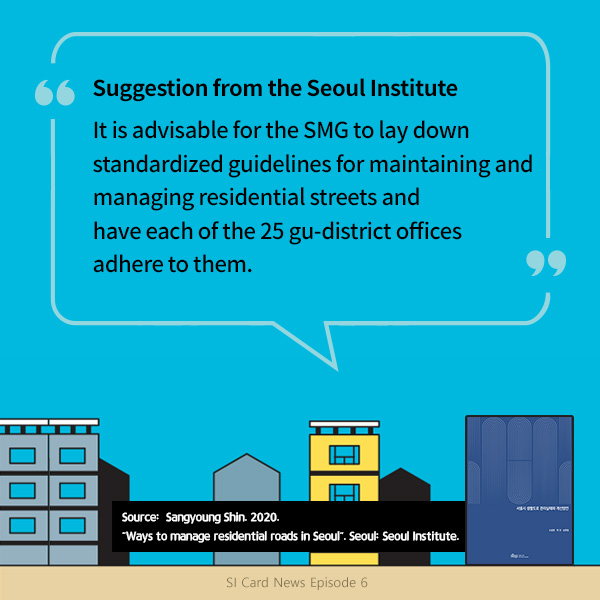Is the Road in front of My House Safe Enough?
[Card News Episode 6] Is the Road in front of My House Safe Enough?
Have you heard of “residential roads”?
A residential road, or residential street, refers to a road or street between 9 and 12 meters wide.
Much of our everyday lives involve residential roads or streets. As separate sidewalks do not exist on most of them, sometimes accidents involving pedestrians occur.
Average Number of Traffic Accidents in Seoul per Year, by road type (2018 – 2020)
All road types 218,909 → On residential streets 103,425 (47.2%)
Residential roads make up 88 percent of the roads in Yangcheon-Gu, 87.1 percent of those in Seongbuk-Gu, 82.3 percent in Gwangjin-Gu, and 82.1 percent in Gwanak-Gu.
- Percentage of Roads narrower than 12 meters in Selected Autonomous gu-districts
- Yangcheon-Gu 88.0%
- Seongbuk-Gu 87.1%
- Gwangjin-Gu 82.3%
- Gwanak-Gu 82.1%
- Seongdong-Gu 81.8%
- Dobong-Gu 81.5%
- Seodaemun-Gu 81.2%
- Eunpyeong-Gu 80.2%
The researchers conducted a survey of 1,000 Seoulites on their perceptions of safety on residential roads.
- Survey overview
- Sample size: 1,000 persons dwelling in Seoul aged 15 and over
* Gender, age and locational distribution considered - Survey period: March 16 – 31, 2021
- Content: · Perception of safety (or risk) of residential roads/streets
· Risk sources associated with disasters and safety hazards
· Thoughts about the current conditions of traffic and safety equipment in terms of quantity and quality
· Improvement priorities concerning risk factors and facility maintenance
- Sample size: 1,000 persons dwelling in Seoul aged 15 and over
Receivers of the survey were asked how safe or unsafe they felt on residential streets in their neighborhoods. The highest percentage of those surveyed (35.2%) consider residential roads near their houses as “fairly unsafe.” Those who think they are “neither safe nor unsafe” and “fairly safe” came next at 34.6% and 24.4%, respectively.
- Perceived Degree of Safety on Residential Streets (Scored on 5-point Likert scale)
- Very unsafe 3.6%
- Fairly unsafe 35.2%
- Neither safe nor unsafe 34.6%
- Fairly safe 24.4%
- Very safe 2.2%
Of particular note is that people in their 30s and 40s, those living in northeast and northwest parts of Seoul, as well as those dwelling in single-family homes, multi-family houses and non-residential buildings have a higher probability of feeling unsafe.
- Perceived Degree of Safety on Residential Streets, by demographic & housing type
- Age group (Unit: Years of age) : 15-19, 20-29, 30-39, 40-49, 50-59, 60+
- Place of residence : Downtown area, Northeast area, Northwest area, Southwest area, Southeast area
- Type of housing : Apartment, Row housing/Multi-unit dwelling, Single-family home/Multi-family home, Non-residential building, Other
More than four in five Seoul survey respondents (82.9%) perceive road crashes as the biggest safety hazard on residential streets, followed by limited capacity to rapidly respond to disasters (77.7%), tripping, slipping, or falling (58.7%), and crime (49.7%).
- Surveyed Top Priorities for Risk Mitigation on Residential Roads
- Pedestrian injury & fatalities (82.9%)
- Inadequate emergency preparedness(77.7%),
- Tripping, slipping, or falling (58.7%),
- Crime (49.7%)
- Collapses or land subsidence (18.7%)
- Flooding (10.0%)
Aside from that, motor vehicles parked or stopped in an unauthorized manner, stacked objects, and litter (including illegally dumped garbage) were cited as problematic.
- Surveyed Top Priorities for Enhancement regarding the Pedestrian Environment on Residential Roads
- Illegally parked or stopped motor vehicles or stacked objects(46.2%)
- Lack of infrastructure ensuring the convenience and safety of pedestrians (43.4%)
- Dearth of CCTV cameras (40.6%)
- Insufficient road cleaning or improperly discarded trash (33.1%)
- Lack of streetlights (29.3%)
Autonomous gu-district offices are limited in their ability to manage residential roads due to their insufficient manpower and resources. Under these circumstances, engaging relevant experts and community members is imperative.
- Group-level : Peace officers, neighborhood watch groups and grassroots organizations patrol or clean up their neighborhoods on a regular basis
- Individual-level : Citizens report hazards or potentially dangerous events to public entities through
a. the 120 Dasan Seoul Call Center
b. official websites of autonomous gu-district offices
c. hazard reporting app and website (Safety e-Report services) which enable people to monitor and participate in monitoring public safety and reporting
d. the Seoul Smart Complaint Report app
Suggestion from the Seoul Institute
It is advisable for the SMG to lay down standardized guidelines for maintaining and managing residential streets and have each of the 25 gu-district offices adhere to them.
Source: Sangyoung Shin. 2020. “Ways to manage residential roads in Seoul“. Seoul: Seoul Institute.
Source: Sangyoung Shin. 2020. “Ways to manage residential roads in Seoul“.

![[Card News / Episode 6] Is the Road in front of My House Safe Enough?](https://www.si.re.kr/sites/default/files/eng_cardnews17_1.jpg)
